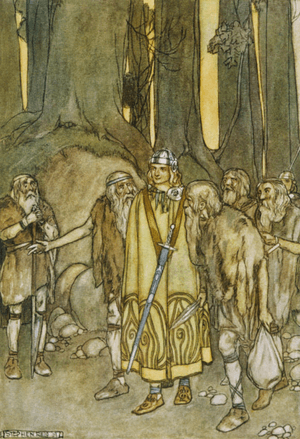Fianna
Fianna (/ˈfiːənə/ FEE-ə-nə, Irish: [ˈfʲiən̪ˠə]; singular fiann; Scottish Gaelic: Fèinne ['feːɲə]) were small, semi-independent warrior bands in Irish mythology. They are featured in the stories of the Fenian Cycle, where they are led by Fionn mac Cumhaill (Finn MacCool). They are based on historical bands of aristocratic landless young men in early medieval Ireland.

Historicity
The historical institution of the fiann is known from references in early medieval Irish law tracts. A fiann was made up of landless young men and women, often young aristocrats who had not yet come into their inheritance of land.[1] A member of a fiann was called a fénnid; the leader of a fiann was a rígfénnid (literally "king-fénnid").[2]
Geoffrey Keating, in his 17th-century History of Ireland, says that during the winter the fianna were quartered and fed by the nobility, during which time they would keep order on their behalf, but during the summer, from Beltaine to Samhain, they were obliged to live by hunting for food and for pelts to sell.[3] Keating's History is more a compilation of traditions than a reliable history, but in this case scholars point to references in early Irish poetry and the existence of a closed hunting season for deer and wild boar between Samhain and Beltaine in medieval Scotland as corroboration.[4]
Hubert Thomas Knox speculates that “they were bodies of Gallowglasses such as appeared in the fifteenth and sixteenth centuries, but then under command of adventurers who were not inhabitants of the province, Free Companies who sold their services to any one who could raise their wages.” [5]
Legendary depiction
Some legendary depictions of fianna seem to conform to historical reality: for example, in the Ulster Cycle the druid Cathbad leads a fiann of 27 men which fights against other fianna and kills the 12 foster-fathers of the Ulster princess Ness. Ness, in response, leads her own fiann of 27 in pursuit of Cathbad.[6]
However, the stories of the Fiannaíocht, set around the time of Cormac mac Airt, depict the fianna as a single standing army in the service of the High King, although it contains two rival factions, the Clann Baíscne of Leinster, led by Fionn mac Cumhaill (Old, Middle, Modern Irish: Find, Finn, Fionn), and the Clann Morna of Connacht, led by Goll mac Morna, and lives apart from society, surviving by hunting.
War cry and mottos
The Dord Fiann or Dord Fiansa[7] was the war-cry of the Fianna, and they frequently employed its use prior to and amid battle, either as a mode of communication or to put fear into their enemies. In the legend "The Death of Fionn", Fionn raises the Dord Fiann when he sees his grandson Oscar fall in battle (Battle of Gabhra) against the armies of Cairbre Lifechair, and proceeds to strike back at the enemy with great furiosity killing many dozens of warriors.[8] The Battle of Gabhra also marked the demise of the Fianna.
They had three mottoes:
- Glaine ár gcroí (Purity of our hearts)
- Neart ár ngéag (Strength of our limbs)
- Beart de réir ár mbriathar (Action to match our speech)
Notable fénnid
- Fionn mac Cumhaill: last leader of the Fianna
- Cumhall: Fionn's father, the former leader
- Goll mac Morna
- Caílte mac Rónáin
- Conán mac Morna
- Diarmuid Ua Duibhne: a warrior of the Fianna who ran off with Fionn's intended bride Grainne and was finally killed by a giant boar on the heath of Benn Gulbain. Foster son of Aengus.
- Lughaid Stronghand: sorcerous warrior, nephew of Fionn mac Cumhaill, one of the four who could have untied the knots Diarmuid bound the sea-kings with, but refused to do so. Lover of Aife, daughter of Manannan
- Oisín, son of Fionn mac Cumhaill: (Macpherson's Ossian)
- Oscar, son of Oisín
- Cael Ua Neamhnainn
Modern use of the term
In more recent history, the name Fianna Éireann has been used, as Fianna Fáil ("the Fianna of Ireland", or Inis Fáil i.e. "the isle of destiny", and hence sometimes rendered "the soldiers of destiny") has been used: as a sobriquet for the Irish Volunteers, on the cap badge of the Irish Army, the name in Irish of the Army Ranger Wing (Sciathán Fiannóglaigh an Airm), in the opening line of the Irish-language version of the Irish national anthem, and as the name of the Fianna Fáil political party.
See also
- Irish Fairy Tales, a 1920 book by James Stephens containing many tales of the Fianna
References
- Dáibhí Ó Cróinín, Early Medieval Ireland, Longman, 1995, p. 88
- Dictionary of the Irish Language, Compact Edition, Royal Irish Academy, 1990, pp. 299, 507
- Geoffrey Keating, Foras Feasa ar Éirinn 2.45
- Nerys Patterson, Cattle Lords and Clansmen: the Social Structure of Early Ireland, University of Notre Dame Press, 1994, p. 122-123
- Hubert Thomas Knox, 'The history of the county of Mayo to the close of the sixteenth century', 1908, p. 13
- Kuno Meyer, "Anecdota from the Stowe MS. No. 992", Revue Celtique 6, 1884, pp. 173-186
- eDIL - "dord", http://www.dil.ie/18319
- Augusta, Lady Gregory - Gods and Fighting Men (1904) Chapter - The Death of Fionn